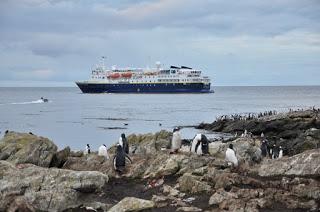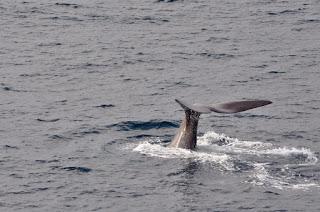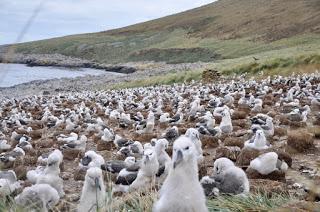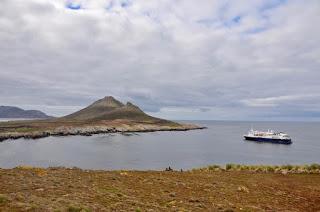 Yesterday I started a multi-part series on my recent trip to the Falkland Islands and South Georgia with Lindblad Expeditions. If you haven't read part 1 of the series yet, you can do so here. In that first article I talked about my brief visit to Buenos Aries, the journey south to Tierra del Fuego, and the start of the actual voyage aboard the National Geographic Explorer. All of that was a necessary part of the story of course, but it also mostly served as a prelude of what was to come.
Yesterday I started a multi-part series on my recent trip to the Falkland Islands and South Georgia with Lindblad Expeditions. If you haven't read part 1 of the series yet, you can do so here. In that first article I talked about my brief visit to Buenos Aries, the journey south to Tierra del Fuego, and the start of the actual voyage aboard the National Geographic Explorer. All of that was a necessary part of the story of course, but it also mostly served as a prelude of what was to come.After setting out from Ushuaia, the Explorer made its way into the southern Atlantic Ocean with our course set for the Falklands. The plan was to spend the first few days sailing to the Falklands and exploring some of the more remote sections of the island before turning south towards South Georgia. We would then spend several days visiting various parts of that remote place, before returning to the Falklands once again to visit even more of the region, before returning home. But that was still more than 2 1/2 weeks off, and things were just getting started.
It took the better part of a day and a half to make our way from Ushuaia to the Falklands, but that gave us time to find our sea legs and become accustomed to life aboard the ship. On a voyage such as this one, you end up spending plenty of time at sea, and you have to be comfortable living in a relatively confined space with few things to do. The Explorer is a very comfortable ship however, and while the cabins are small, they are cosy too. Each one is outfitted with a television set with on demand movies if you want to spend some time in your room, but the very knowledgeable and friendly crew also give lectures several times a day, and several National Geographic photographers also provide workshops throughout the voyage as well. Passengers gather regularly in the lounge areas to swap stories, talk about their experiences, and get to know one another too. Meals are served like clock work, snacks and drinks are available as needed, and in general you don't really want for much of anything.
That isn't to say that life at sea is without incident. During our voyage to the Falklands for instance, we spotted several variety of whales, including southern right whales and sperm whales. These massive mammals regularly put on a show for us, spewing water high into the air and slapping their tales as they dove back under the water. The crew of the Explorer were always quick to point them out when they were spotted out on the water, and the ship would even slow down to allow passengers to take photos or simply enjoy watching the giant sea creatures swim past.
 Whenever we spotted a whale, passengers would don their warm jackets and file out onto the decks of the ship to get a better view. After departing from South America, the conditions got a bit cooler, but not uncomfortably so. Still, at times there were brisk winds blowing across the South Atlantic, which definitely were a wake-up call when wandering outside.
Whenever we spotted a whale, passengers would don their warm jackets and file out onto the decks of the ship to get a better view. After departing from South America, the conditions got a bit cooler, but not uncomfortably so. Still, at times there were brisk winds blowing across the South Atlantic, which definitely were a wake-up call when wandering outside.Eventually we made our way across the open ocean and arrived at the outer islands of the Falklands. While I was there in March, we actually had a window of excellent weather, which made the seas a bit calmer and conditions more manageable. Because of this, our expedition leaders decided that they wanted to attempt a wet landing at place called Steeple Jason Island, which often inaccessible due to tides and swells. In fact, there were a number of members of the crew the had never been there before, while others hadn't stepped foot on the island in years.
During my voyage with Lindblad the ship wasn't especially full. In fact, the Explorer is usually home to about 150 passengers, but on my trip there was only about a third of that number. That's rough for the business, but great for logistics, as it meant that all of us could go ashore relatively quickly, and when visiting protected places like Steeple Jason, we were allowed to have everyone on the beach at the same time. This would prove extremely helpful over the course of the trip, allowing us to get in and out of places more efficiently and ultimately providing us with more times at various stops along the way. With a larger group of travelers things can get unwieldy, but that was never the case on this expedition.
Upon approaching Steeple Jason, we all loaded up into Zodiac inflatable boats and were driven to shore, where we jumped out into the water and scrambled over a rocky outcropping to reach dry land. Once there, we were immediately greeted by a colony of gentoo and Magellanic penguins and a few fur seals frolicking in the water. But, we didn't spend much time taking in those sights as there was another destination that our guides had in mind.
Soon we were hiking across the open landscape, which mostly covered in short grass with a few small trees found here and there. The plan was to hike for a couple of miles to reach the nesting ground of the black-browed albatross. You see, Steeple Jason is home to the largest colony of those birds, and during the nesting season they number in the hundreds of thousands. It is estimated that 70% of their population call this island home, and after seeing them stretched out before us, it is difficult to argue with that number.
 Making our way through taller grass, often head-high, we were able to creep up to the edge of the colony, where thousands of adolescent albatrosses were still sitting on nests. Occasionally a full-grown adult would soar back in, deliver some food, and sail back out to sea in search of more nourishment. It was a fascinating process to watch and it seemed unreal that so many very large birds could be found in such a small area.
Making our way through taller grass, often head-high, we were able to creep up to the edge of the colony, where thousands of adolescent albatrosses were still sitting on nests. Occasionally a full-grown adult would soar back in, deliver some food, and sail back out to sea in search of more nourishment. It was a fascinating process to watch and it seemed unreal that so many very large birds could be found in such a small area.As the morning progressed, I began to get itchy feet, so myself and a few other passengers set off to see what else Steeple Jason had to offer. We climbed up to a high ridge that ran along the length of the middle of the island and were able to gain a vantage point that allowed us to see for miles in all directions. The edges of the island were evident from way up there, and beyond was nothing but the Atlantic Ocean and a few other smaller islands in the distance. It was a sweeping look at this remote corner of the world, which was incredibly beautiful even in its starkness.
After a few hours on Steeple Jason we returned to the Explorer for lunch and to set sail for yet another destination. This time, we would go to a place called Carcass Island, where we would come ashore on a lovely beach and once again walk amongst the penguins and seals while a variety of sea birds hovered overhead.
During the walk along the beach our team ended up spitting into two. Most of the other passengers elected to stay along the shore and make their way towards a small homestead that could be seen in the distance. A few of us however, turned uphill and once again climbed to the top of a high ridge to get a better vantage point. By that time, the sun was high overhead and gleaming off the water, making the effort to get up to the higher points worth it.
 Most of us were wearing boots designed for use in mud and water, and they weren't always the best for hiking. But, everyone made due and trudged along nicely. But, eventually we had to rejoin our team back down below, so we descended to the small farm where the others gathered only to be greeted to a tremendous site. The family that lived on the island had opened their home to us visitors and had put out quite an impressive spread. A table filled with cookies, cakes, and candies of all sorts awaited us, with tea and coffee on the offering as well. It was an unexpected and tasty surprise, but one that we all welcomed.
Most of us were wearing boots designed for use in mud and water, and they weren't always the best for hiking. But, everyone made due and trudged along nicely. But, eventually we had to rejoin our team back down below, so we descended to the small farm where the others gathered only to be greeted to a tremendous site. The family that lived on the island had opened their home to us visitors and had put out quite an impressive spread. A table filled with cookies, cakes, and candies of all sorts awaited us, with tea and coffee on the offering as well. It was an unexpected and tasty surprise, but one that we all welcomed.From there, it was back to the ship to get underway once more. It had been a day that none of us would soon forget, as we not only had gotten a glimpse of the Falklands' more remote and uninhabited areas, but also what life is life for the settlers who live in various parts of the region. The family living on Carcass Island eked out a living by raising sheep and welcoming travelers, but they were also far from any neighbors or towns. Still, they did have Internet service and wifi, and their home was warm and inviting. What more can you ask for in life?
The following day we made yet one more stop in the Falklands, going ashore on another island before turning south to head towards the Southern Ocean and the infamous Drake Passage. While I had definitely enjoyed my first visit to the Falklands, were now turning towards South Georgia, a place I had read about many times but never had expected to see. It would take two days to get there, but it would be worth the wait, as the place met and exceeded all of my expectations.
More to come soon!

